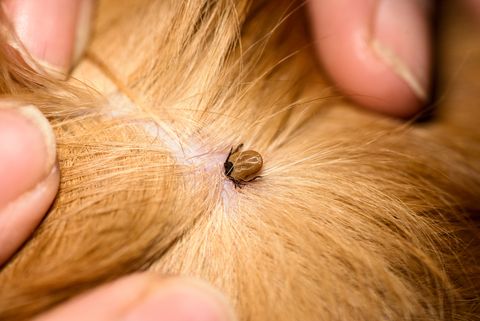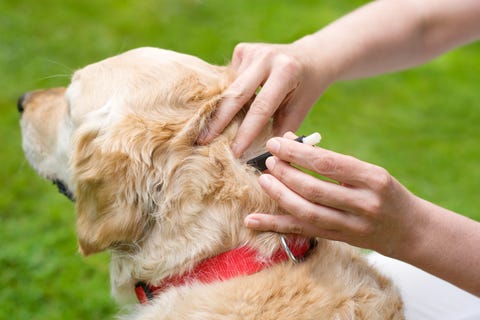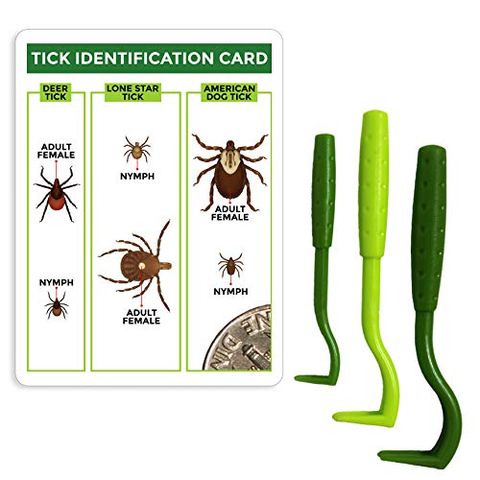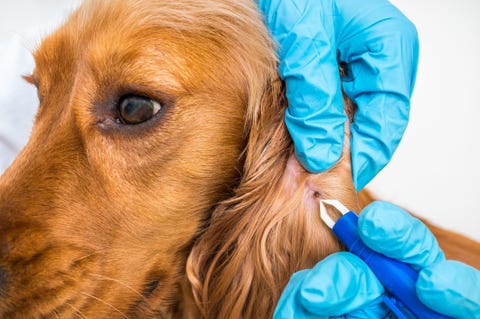How to Get Rid of Dog Odor in House
A guide on everything you need to know about ticks on dogs, including how to spot ticks, how to remove ticks from your dog's fur and the risk of your dog contracting Lyme disease.
It's not unusual for dogs to have ticks, as the little spider-like parasites can easily attach themselves to their coat while out on walks. Ticks can't jump or fly, so sit at the tip of grass and plants waiting to brush on to the skin, before crawling to a comfy spot and filling up on mammalian blood. Hedgehogs, cats, sheep, deer and humans can all end up with ticks. They tend to be most active in the spring and autumn months.
Checking your dog's fur for ticks after a walk in the woods or long grass is essential. Most ticks are harmless, but can cause discomfort to your pet. Dogs can also catch Lyme disease which is hard to diagnose, but a serious and debilitating condition.
Here, everything you need to know about ticks on dogs...

IgorChus Getty Images
Where do ticks live?
You are most likely to come into contact with ticks in areas of dense vegetation including long grass and woodland. They can not fly so attached themselves to animals when they brush past them. They are likely to be found close to animal habitats including deer, rabbits and rodents.
Ticks are most active during spring as this is the point, every year in their three-year lifespan (approx.), that they look for a host to feed off.
What does a tick look like on a dog?
Ticks come in many sizes and shapes, but generally they're small, flat, black and an oval shape. Once they've gorged on blood, ticks usually expand to the size of a small coffee bean. They can look like a wart in a dog's fur, but on closer inspection you'll be able to see their eight legs.
How do I know if my dog has ticks?
Make a habit of running your hands through your dog's fur after a walk to feel for any lumps and bumps. Pay particular attention to your pet's neck, head, ears, groin, muzzle, pads and toes, as these are the places ticks can attach themselves to dogs most easily. Regular brushing, shampooing and grooming can also help keep on top of ticks.

PK-Photos Getty Images
What are the side effects and diseases a dog can get from a tick?
Most ticks are harmless but can cause discomfort for your dog. There are, however, a few diseases that can be passed from tick to dog. They include:
Lyme disease – The main concern is whether a tick is carrying Lyme disease which could be passed on to your dog. Lyme disease is an inflammatory condition which can become severe if left untreated. The most common symptoms of Lyme disease in dogs include a lesion around the bite, stiffness, lameness, swollen joints, inflamed lymph nodes, tiredness, fever and loss of appetite. If you are concerned about any of these symptoms in your dog, visit your vet immediately.
Ehrlichiosis (very rare in UK) – Ehrlichiosis is a tick-borne disease which affects white blood cells. It is very rare for people to catch Ehrlichiosis from a tick bite, with Vets Now reporting only 10-20 confirmed cases a year in the UK. Dogs catching Ehrlichiosis in the UK is also very rare. There is a greater risk in Europe, America and Africa so dogs traveling to and from these places should be checked. Symptoms of Ehrlichiosis in dogs include fever, weight loss, stiffness and bleeding.
Babesiosis (very rare in UK) – Similarly to the above, Babesiosis is a rare tick-borne disease. In this case, it affects red blood cells. Again, the real risk comes from dogs traveling to and from countries where the risk is higher, including Europe, Africa and Asia. Symptoms of Babesiosis in dogs include fever, loss of appetite, weakness and brown urine.
What should I do if my dog has ticks?
Ticks can carry infection so it's important to remove them quickly. But, pulling a tick from your dog's coat is a no-no. Not only do the parasite's legs and mouth often remain embedded in the skin, potentially causing infection, inflammation and them to regurgitate infected blood back into your pet, but this can hurt your dog.
How do I safely remove a tick from my dog?

TickCheck Tick Remover Tools and Tick Identification Card for Humans, Dogs & Cats 1 Set (Pack of 3)
TickCheck amazon.co.uk
Speak to your vet about tick removal devices. They're inexpensive and can be picked up at their practice or your local pet shop. Once the tick has been removed you should clean the bitten area.
How to prevent ticks on dog and tick bites?
Your vet can recommend effective tick prevention treatments such as collars, tablets and on-the-spot treatments to help stop the parasite attaching itself to your dog. It's also worth asking your vet if you live in a high tick area.
Make sure you regularly check for ticks after walks and when brushing your dog, too. Do this by brushing their coat against the direction of hair growth so you can see the skin.
The Kennel Club recommends carrying a tick removal tool with you when out and about with your pet, along with antiseptic wipes. Stick to paths, treat pet accessories with repellants, use tick-control products and deter ticks from your garden by keeping the grass short, too. Read more tick prevention tips from the Kennel Club here.

andriano_cz Getty Images
How long do ticks survive?
Every spring, female ticks lay up to 2,000 eggs before they die. Once the eggs hatch in the summer, tiny six-legged larvae will be inactive for a year while they develop. The following spring, they will climb up foliage and wait for a host to attach themselves to.
Once a tick has latched onto an animal – a dog, human, cow or sheep, for example – it will spend a week feeding off its blood before dropping onto the ground. During a tick's lifetime, they look for three hosts over three years, before laying eggs and dying off.
Can dogs get Lyme disease?
Just like humans, dogs can contract Lyme disease by coming into contact with infected ticks – that's why quickly, safely and effectively removing ticks from your dog's coat is essential.
Symptoms of Lyme disease in dogs include fever, lameness, swollen and painful joints, and swollen lymph nodes, according to the Blue Cross. Contact your vet immediately if you think your dog may have Lyme disease. They will be able to prescribe antibiotics.
Can dog owners get Lyme disease from ticks?
Humans can contract Lyme disease if bitten by an infected tick. They can be bitten directly when out in tick habitats or bitten at home by a tick who has attached itself to their dog. It is worth noting, however, that very few ticks are infected with Lyme disease.
Lyme disease appears in humans as a red rash around the tick bite, which lasts for several weeks. The rash most commonly appears within four weeks of the bite but can be delayed by up to three months. Early signs of Lyme disease can also include flu-like symptoms such as headaches, muscle pain and tiredness. Contact your GP for treatment.
Should I worry about ticks on my dog?
Being prepared and taking preventative steps to avoid ticks on your dog will decrease worry. The possibility of a dog contracting Lyme disease is a cause for concern but, on the whole, ticks are harmless. Make sure you know what to do and have a tick remover to hand so you feel prepared.
Like this article? Sign up to our newsletter to get more articles like this delivered straight to your inbox.
SIGN UP
6 fun dog toys every pup will love

Activity Game
Trixie amazon.co.uk
£11.49

Beef Scented Five Senses Ball
SHARPLES amazon.co.uk
£7.68

Hide and Seek Puzzle
IFOYO amazon.co.uk
£20.99

Dog Toy
Rosewood amazon.co.uk
£7.99

Rubber Dog Balls
LEESITEC amazon.co.uk
US$10.19

This content is created and maintained by a third party, and imported onto this page to help users provide their email addresses. You may be able to find more information about this and similar content at piano.io
How to Get Rid of Dog Odor in House
Source: https://www.countryliving.com/uk/wildlife/pets/a28757972/ticks-on-dogs/